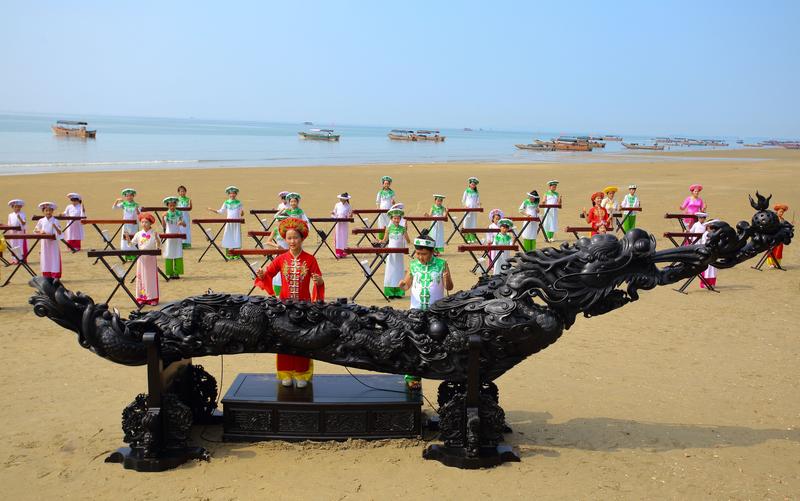The duxianqin is not only an essential element of the Jing ethnic group's artistic identity, but can also be used to build a cultural bridge between people, report Chen Nan and Shi Ruipeng in Nanning.
 Su Haizhen's students play duxianqin on the beach of Wanwei, an island in Dongxing, Guangxi Zhuang autonomous region, on Nov 18, 2021. (HUANG TIANFU / FOR CHINA DAILY)
Su Haizhen's students play duxianqin on the beach of Wanwei, an island in Dongxing, Guangxi Zhuang autonomous region, on Nov 18, 2021. (HUANG TIANFU / FOR CHINA DAILY)
Duxianqin, or one-string dulcimer, is a traditional musical instrument of the Jing ethnic group. As its name suggests, the old musical instrument — with a history dating to the 8th century — has only one string and is capable of producing two different sounds at the same time.
The performers usually hold the instrument with their left hand and pluck the string with a tiny piece of bamboo with their right. While plucking the instrument's string, the performers simultaneously control the pitch by moving a "wand" which protrudes upward, to adjust the tension on the string.
I am captivated by the sounds of the musical instrument. It’s amazing that one string can produce such a wide range of melodies.
Su Haizhen, duxianqin artist and inheritor of the national intangible cultural heritage
Su Haizhen grew up listening to the unique musical instrument, which is often performed as an accompaniment to folk songs of the Jing ethnic group and during its traditional folk festivals.
"The sounds of duxianqin are similar to the pronunciation of Jing language, which is both soft and produces a strong nasal tone. I always feel close to the musical instrument," says Su.
She started learning to play duxianqin at 8 years old. Now, as an inheritor of the musical instrument, which was listed as a part of China's national intangible cultural heritage in 2011, Su is the head of Dongxing Jing Ecomuseum, which is located in Jiangping town, Dongxing, Guangxi Zhuang autonomous region. Founded in 2008, the ecomuseum is dedicated to preserving and promoting the history and culture of the Jing ethnic group.
Among China's ethnic groups, the Jing people are the only group known for their marine culture, with a small population of about 30,000. The majority of the population live on three islands in Dongxing: Wanwei, Wutou and Shanxin.
"I am captivated by the sounds of the musical instrument. It's amazing that one string can produce such a wide range of melodies, isn't it?" says the 50-year-old, adding that duxianqin is an indispensable part of life for the Jing people, who largely live in coastal areas and earn a living by fishing.
"People play the musical instrument as a daily entertainment and on special occasions, such as traditional festivals, weddings and family reunions," she adds.
 Su in traditional Jing ethnic clothes showcasing her duxianqin. (HUANG TIANFU / FOR CHINA DAILY)
Su in traditional Jing ethnic clothes showcasing her duxianqin. (HUANG TIANFU / FOR CHINA DAILY)
Su's father, Su Weiguang, was a singer, poet and writer, who was keen on collecting items pertaining to, and doing research about, the culture of the Jing ethnic group. He not only translated old folk songs from the Jing language into Mandarin, but also wrote lots of folk songs himself. Su Haizhen's mother, Ruan Chengzhen, was a dancer, who specialized in performing folk dances of the Jing ethnic group.
As children, both Su Haizhen and her elder sister, Su Haiying, learned to perform folk songs with their parents. In 1987, Su Haizhen studied at the Art School of Guangxi, majoring in duxianqin performance. In 1994, she traveled to Beijing to study at Minzu University of China, where she majored in vocal performance.
"Duxianqin is a minority art, with very few people playing it. Back then, there was nobody who could teach the musical instrument at the university," says Su Haizhen. "I want to popularize the musical instrument, which is crucial for both the Jing people and their culture."
As a member of the 14th National Committee of the Chinese People's Political Consultative Conference, Su Haizhen has another important mission besides preserving and promoting duxianqin.
Dongxing is a border town adjoining Vietnam. Su Haizhen is also devoted to deepening the friendship and ties between China and its neighbor through duxianqin, since the musical instrument is also played in Vietnam.
In 2005, she traveled to Vietnam and studied the musical instrument with established duxianqin players there.
"It was a memorable experience because the teachers were very strict and many songs were new to me. I spent about seven hours a day practicing," recalls Su Haizhen.
That year, Su Haizhen recorded and released an album, titled Hai Yun Mei Ying, featuring 11 original folk songs played on duxianqin, which was the first album in the country dedicated to the musical instrument. In 2007, she released her second album, Hai Shi Shen Lou.
Since 2012, Su Haizhen has been teaching young Jing people to play duxianqin by working with local schools and she continues to grow appreciation for the instrument by performing on TV shows. She has also founded a duxianqin ensemble, which involves about 100 players and plays during the annual traditional hajie (singing festival), or the Changha festival for the Jing people.
Contact the writers at chennan@chinadaily.com.cn


